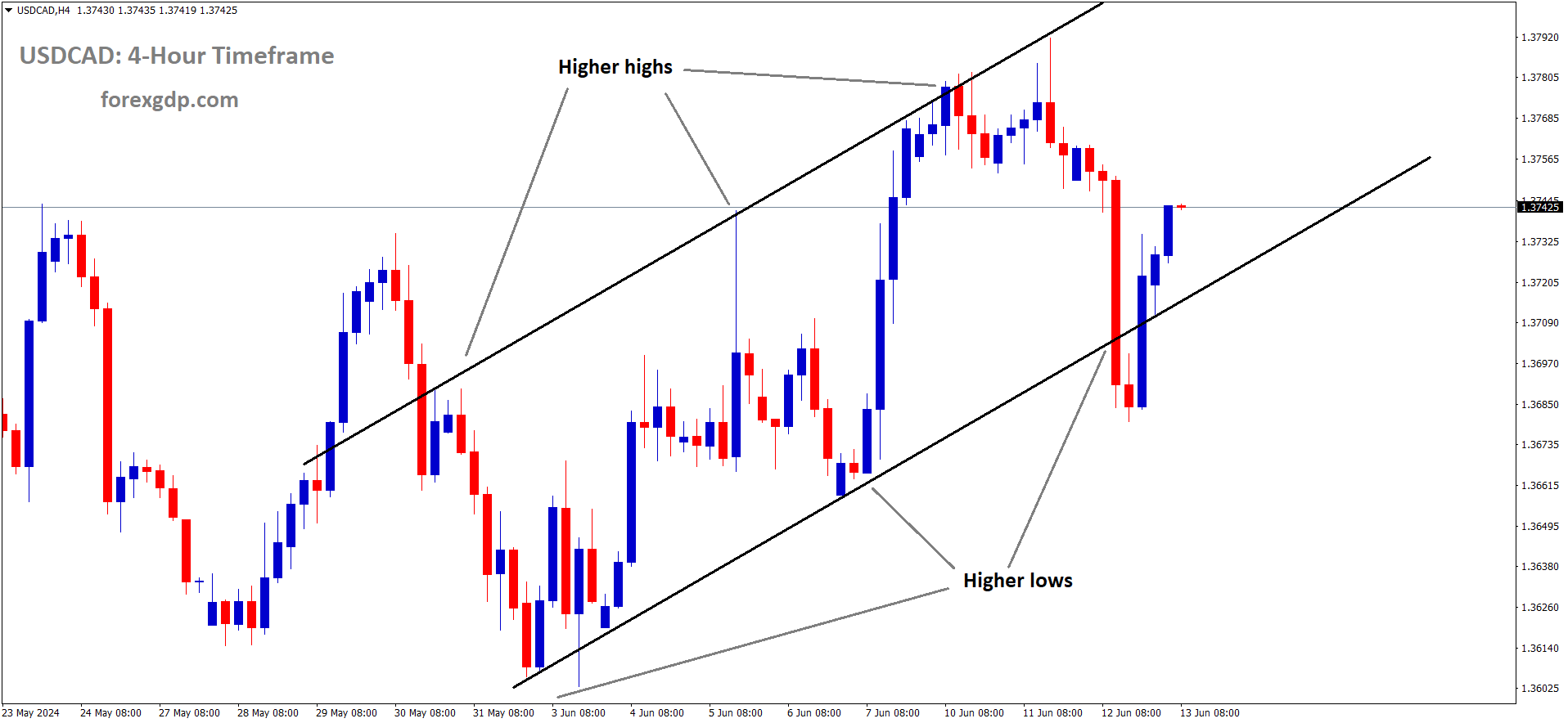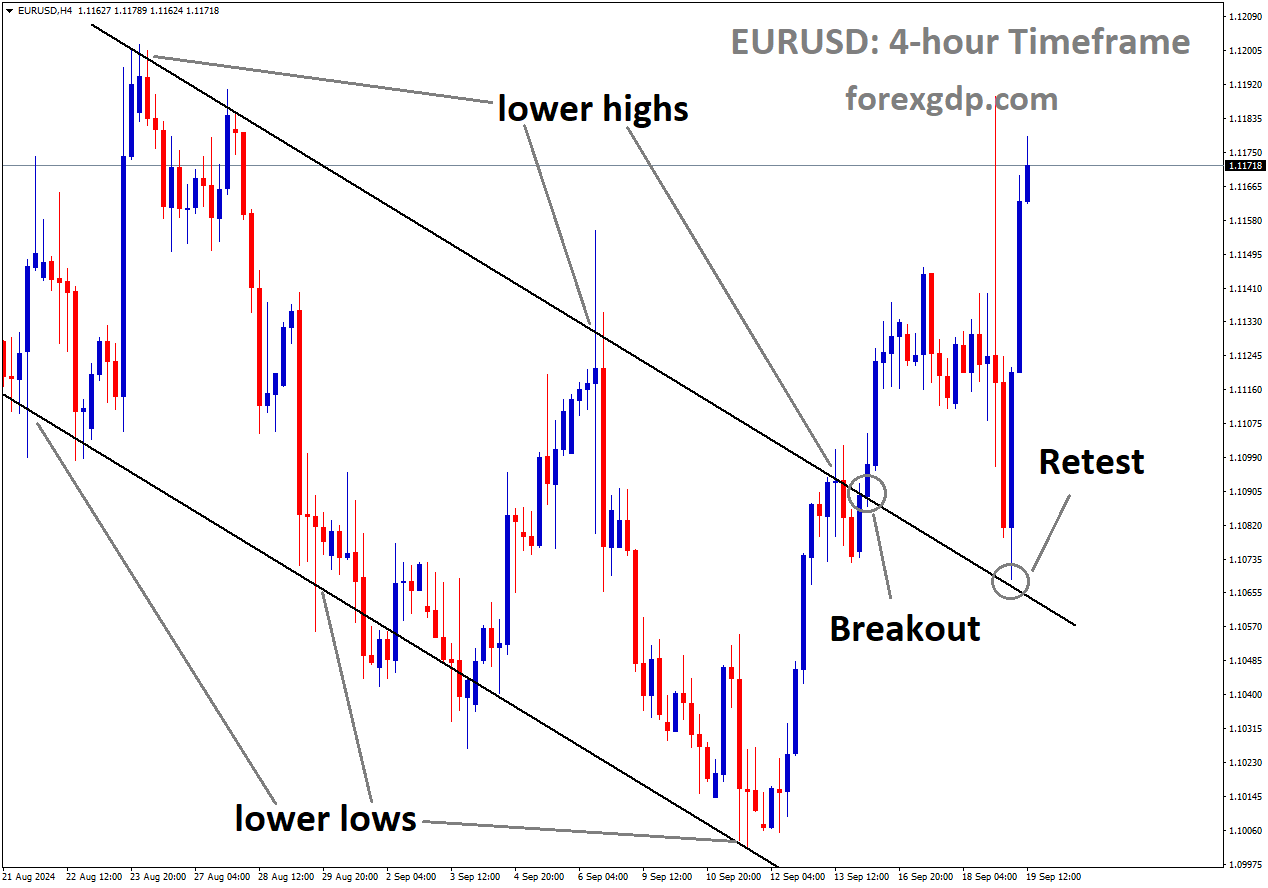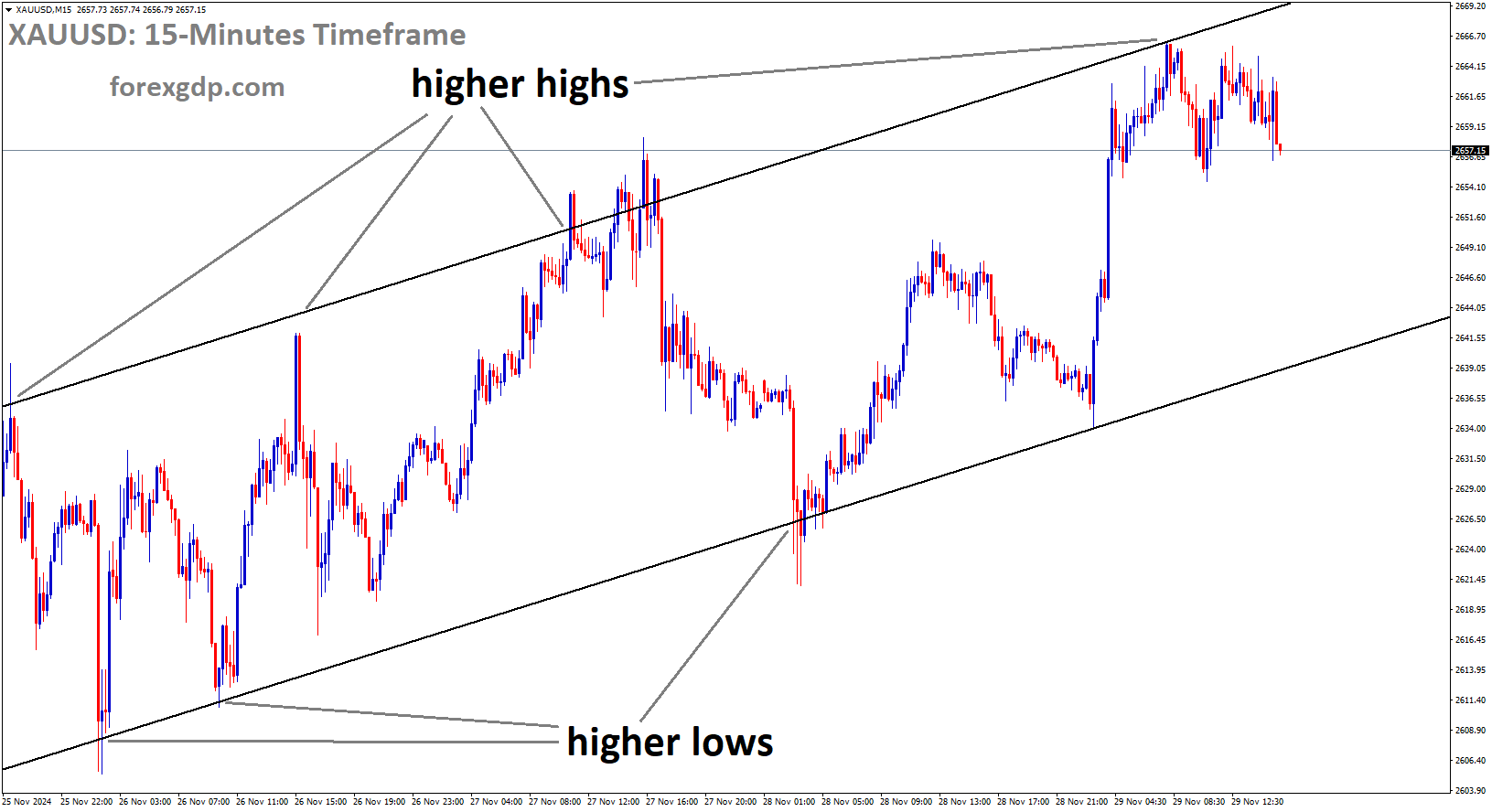USD: Powell Discusses Rate Outlook After Policy Hold
US FED meeting outcome is rate unchanged at 5.25%-5.50% yesterday, FED Powell said we still have no confidence on inflation to do rate cut in the US economy. Labour Market well tight like before the pandemic time, inflation in the housing market is higher, we have to bring down this inflation first, then only we get inflation back to 2%target. Not only seeing wages is the big picture for inflation reading contribution, but also Housing market pressures the inflation up in the market.
USDCHF is moving in Descending channel and market has rebounded from the lower low area of the channel
Federal Reserve Chairman Jerome Powell explains the decision to leave the policy rate, known as the federal funds rate, unchanged within the range of 5.25% to 5.5%. He also responds to questions during the post-meeting press conference.
Follow our live coverage of the Federal Reserve’s policy announcements and the subsequent market reaction.
Key Takeaways from the Fed Meeting Press Conference:
- A broad set of indicators suggest the labor market is back to where it was on the eve of the pandemic.
- Overall, the broad set of indicators in the labor market shows it is relatively tight but not overheated.
- We expect labor market strength to continue.
- More recent readings on inflation have shown easing.
- So far this year, we have not gained greater confidence in inflation to warrant a rate cut.
- We will need to see more positive data to bolster confidence in inflation.
- If the economy remains solid and inflation persists, we will keep rates at the current level for as long as needed.
- The opposite is also true in terms of potential rate cuts.
- Our policy is well-positioned, and we will continue to make decisions on a meeting-by-meeting basis.
- We need further confidence and more positive inflation readings, but we won’t specify how many are needed to start cutting rates.
- We will also be looking at the balance of risks and the overall outlook.
- Unexpected weakness in the labor market could also prompt a response.
- We will be monitoring the labor market for signs of weakness, but we are not seeing that right now.
- We do not see ourselves as having the confidence that would warrant policy loosening at this time.
- I like to look at 3-month and 6-month series on payroll reports given differences between the establishment and household surveys.
- The overall picture is one of a strong and gradually cooling labor market.
- People are coming to the view that rates are less likely to return to pre-pandemic levels.
- We are making policy with the economy we have and the distortions we face.
- The question of whether the policy is restrictive enough will be answered over time.
- We are prepared to adjust policy as appropriate.
- The housing situation is complicated.
- Ultimately, the best thing we can do for the housing market is to bring inflation down.
- The banking system has been solid, strong, and well-capitalized.
- Wages are still running above a sustainable path.
- Wages are not the principal cause of inflation, but they need to come down for overall inflation to return to 2%.
The US Federal Reserve announced on Wednesday that it left the policy rate, the federal funds rate, unchanged within the range of 5.25% to 5.5% following the June policy meeting. This decision was in line with market expectations.
Key Takeaways from the Federal Reserve’s Policy Statement and the Dot Plot:
- The revised Summary of Economic Projections, also known as the dot plot, published alongside the policy statement, showed that:
4 out of 19 officials saw no rate cuts in 2024,
7 projected a 25 basis points (bps) rate reduction,
8 marked down a 50 bps cut in the policy rate.
- Fed officials’ median view of the federal funds rate at the end of 2024 is 5.1% (previously 4.6%).
- Fed officials’ median view of the federal funds rate at the end of 2025 is 4.1% (previously 3.9%).
- Fed officials’ median view of the federal funds rate at the end of 2026 is 3.1% (unchanged from previous projection).
- Fed officials’ median view of the federal funds rate in the longer run is 2.8% (previously 2.6%).
- Fed projections imply 25 bps of rate cuts in 2024 from the current level, and another 100 bps in 2025.
- Fed policymakers see end-2024 PCE inflation at 2.6% versus 2.4% in the March projection; core inflation is seen at 2.8% versus 2.6%.
- Fed policymakers see 2.1% GDP growth in 2024, with the unemployment rate at 4%; both unchanged from the March projection.
- Forecasts show 2025 PCE and core PCE inflation at 2.3% versus 2.2% in the March projection.
- There has been modest further progress toward the 2% inflation objective.
- The Fed does not expect it will be appropriate to reduce the policy target range until gaining greater confidence that inflation is moving sustainably toward 2%.
- The economy continues to expand at a solid pace, job gains remain strong, and the unemployment rate remains low.
- Inflation has eased over the past year but remains elevated.
- Risks to achieving policy goals have moved toward a better balance.
- The Fed will continue to reduce its holdings of Treasuries and mortgage-backed securities.
- The vote in favor of the policy was unanimous.
USD: US Fed Meeting: Powell’s FOMC Keeps Key Rates Steady at 5.25-5.50% for 7th Straight Time
US Fed Meeting Outcome:
The US Federal Reserve announced yesterday that it will keep the benchmark interest rates unchanged at 5.25% to 5.50%. This decision follows the two-day Federal Open Market Committee (FOMC) meeting.
USD Index Market price is moving in box pattern and market has fallen from the resistance area of the pattern
Key Statements from Fed Chairman Jerome Powell:
Inflation and Rate Cuts: Powell emphasized that the Fed still lacks confidence in the current inflation trends to consider a rate cut. Despite some easing, inflation has not yet reached a level that warrants reducing rates.
Labor Market: The labor market remains tight, similar to conditions before the pandemic. The strength in the labor market is expected to continue, which supports economic stability.
Housing Market: Inflation in the housing market is notably high. Powell highlighted that bringing down inflation in the housing sector is crucial for achieving the overall 2% inflation target. The pressures from the housing market significantly contribute to the inflation reading.
Wages and Inflation: While wages are an important factor, they are not the sole contributor to inflation. The housing market also plays a critical role in driving up inflation. Therefore, addressing housing market inflation is essential for the Fed’s broader inflation goals.
Summary:
Interest Rates: The Fed has decided to keep the interest rates unchanged at 5.25% to 5.50%.
Inflation Concerns: The Fed is not confident enough about the current inflation trends to cut rates. Housing market inflation remains a significant concern.
Labor Market: The labor market remains tight, similar to pre-pandemic levels.
Housing Market Impact: Reducing inflation in the housing market is a priority to achieve the 2% inflation target.
Comprehensive Approach: The Fed considers both wages and housing market pressures when assessing inflation.
This decision and the accompanying statements underscore the Fed’s cautious approach in responding to inflation and its commitment to bringing it down to the target range.
US Fed Meeting Outcome LIVE Updates:
The US Federal Reserve announced its interest rate decision on Wednesday following a two-day Federal Open Market Committee (FOMC) meeting. The decision was to leave the benchmark interest rates unchanged at 5.25% to 5.50% for the seventh consecutive meeting, aligning with Wall Street estimates.
The rate-setting panel concluded its fourth policy-setting meeting of the year on June 12 and unanimously voted to maintain the policy rate at the two-decade high. The projections on rate cuts for 2024 are data-dependent, indicating that Fed policymakers will frequently revise their plans for rate hikes or cuts based on the evolution of economic growth and inflation.
Key Highlights:
Policy Rate Decision: The Federal Reserve has held the policy rate steady, marking the seventh straight meeting without a change, maintaining the range of 5.25% to 5.50%.
Economic Projections: The Fed raised its core inflation forecast for 2024 while keeping GDP projections unchanged. This reflects ongoing concerns about inflation while maintaining a stable outlook for economic growth.
Inflation Data: US consumer prices were flat in May compared to April, which slowed the annual rate of inflation to 3.3% from 3.4%. The core consumer price index (CPI), which excludes food and energy costs, rose at a year-over-year rate of 3.4%, the slowest pace in more than three years.
Historical Context: Since March 2022, the Fed has raised the policy rate by a total of 5.25 percentage points in response to rising price pressures. This series of rapid rate increases was among the swiftest in the Fed’s history.
Current Stance: The Fed has kept the policy rate on hold since July 2023, aiming to anchor high inflation and consistently bring it down toward the target range of 2%.
Future Outlook: The projections for potential rate cuts in 2024 remain highly dependent on incoming economic data, particularly concerning inflation and growth metrics.
By maintaining the current rates and adjusting forecasts, the Fed continues to balance its goals of managing inflation and supporting economic growth. The central bank’s future actions will be guided by economic developments and inflation trends.
USD: Fed Holds Rates Steady, Lowers 2024 Cut Forecast Amid High Inflation
US Fed Meeting Outcome
Interest Rate Decision:
Rate Unchanged : The Federal Reserve decided to keep the key interest rate unchanged at 5.25% to 5.50%.
Key Remarks from Fed Chair Jerome Powell:
Inflation Concerns: Powell emphasized that the Fed does not have enough confidence in the current inflation trends to justify a rate cut.
Labor Market: The labor market remains tight, similar to conditions before the pandemic.
USDCAD is moving in Ascending channel and market has rebounded from the higher low area of the channel
Housing Market Inflation: Inflation in the housing market is notably high. Powell highlighted the need to address this inflation before overall inflation can be brought down to the 2% target.
Contributing Factors to Inflation: While wages are a significant factor, the housing market also plays a critical role in driving inflation. Reducing inflation in the housing sector is essential for achieving the Fed’s broader inflation goals.
Summary:
Interest Rates: Held steady at 5.25% to 5.50%.
Inflation Strategy: Focused on reducing housing market inflation to meet the 2% target.
Labor Market: Continues to be strong and tight.
Inflation Drivers: Both wages and housing market pressures are significant contributors to overall inflation.
US Fed Meeting Outcome LIVE Updates
The US Federal Reserve announced on Wednesday that it will keep its key interest rate unchanged at 5.25% to 5.50%, marking the seventh consecutive meeting with no rate change. This decision aligns with Wall Street estimates and follows a two-day Federal Open Market Committee (FOMC) meeting.
Key Points from the Meeting:
- Interest Rate Decision: The Fed maintained the benchmark interest rates at 5.25% to 5.50%.
- Rate Cut Forecasts: The Fed scaled back its forecast from three rate cuts to just one for 2024 after a pickup in inflation early in the year. The outlook is data-dependent, with policymakers revising their plans based on economic growth and inflation trends.
- Inflation Trends: US consumer prices were flat in May compared to April, slowing the annual inflation rate to 3.3% from 3.4%. The core consumer price index (CPI), which excludes food and energy, rose 0.2% month-over-month, bringing the annual increase down to 3.4% from 3.6%.
- Fed’s Statement on Inflation: The central bank acknowledged modest progress towards its 2% inflation objective, noting an easing of price pressures in recent months. However, it reiterated that a reduction in the target range would not be appropriate until there is greater confidence that inflation is sustainably moving toward the 2% goal.
- Labor Market: The labor market remains tight, similar to pre-pandemic levels. Despite strong job growth and low unemployment, inflation in the housing market remains high, contributing to overall inflation pressures.
- Future Rate Cuts: The Fed now estimates a single quarter-point rate cut in 2024, reducing the federal funds rate to a range of 5% to 5.25% by year-end. This is fewer than the three cuts projected in March. Policymakers are divided, with some predicting two cuts and others foreseeing none.
- Long-Term Rate Projections: The Fed anticipates four rate cuts in 2025 and another four in 2026, aiming to lower the key rate to 3.1% by the end of 2026.
- Economic Growth and Inflation: The Fed expects the economy to grow by 2.1% this year and 2% in 2025. Annual inflation, as measured by the personal consumption expenditures (PCE) index, is projected to fall to 2.6% by December, slightly above the 2.4% predicted in March. Core PCE inflation is expected to remain at 2.8% by year-end.
Jerome Powell’s Comments:
Inflation: “We want to see more good data to bolster our confidence that inflation is moving sustainably toward 2%.”
Progress: “Today’s report is progress and builds confidence. This is a step in the right direction but it really is only one reading. We hope we get more like it.”
Current Interest Rate:
The Fed’s decision leaves its benchmark short-term interest rate at a 23-year high of 5.25% to 5.50%. This means higher borrowing costs for consumers on mortgages, credit cards, and auto loans, but also higher savings yields from banks.
Historical Context:
Since March 2022, the Fed has raised the federal funds rate 11 times from near zero to address pandemic-induced inflation. After peaking at a 40-year high of 9.1% in mid-2022, inflation has eased significantly, although progress stalled earlier this year due to gradual wage growth and persistent price increases in services.
Future Expectations:
Rate Cuts: Some economists believe the Fed might still implement two rate cuts this year, depending on incoming data, particularly regarding employment and price trends.
Job Market: The current 4% unemployment rate is projected to remain unchanged through 2024. Although hiring has slowed, employers have been hesitant to lay off workers due to previous labor shortages.
Wage Growth: Average yearly wage growth has declined but remains above the level needed to align with the Fed’s 2% inflation target.
Conclusion:
The Fed remains cautious, balancing the need to control inflation with the goal of sustaining economic growth. Future policy decisions will be closely tied to ongoing economic data and inflation trends.
Don’t trade all the time, trade forex only at the confirmed trade setups
Get more confirmed trade signals at premium or supreme – Click here to get more signals , 2200%, 800% growth in Real Live USD trading account of our users – click here to see , or If you want to get FREE Trial signals, You can Join FREE Signals Now!











